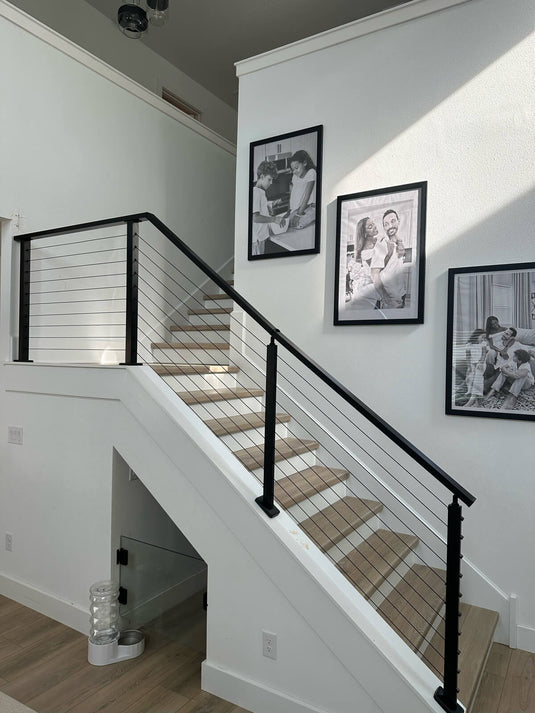TABLE OF CONTENTS
Floating Stairs for Small Spaces: Sleek Solutions for Tight Quarters
😥Is your staircase eating up too much space in your already tiny home?
🤔Looking for a safe and sleek way to connect levels in your compact loft?
😩Tired of staircase designs that look heavy, outdated, or out of place?
If you've ever felt like your staircase is more of a burden than a feature, you're not alone. Many homeowners face the challenge of balancing function and aesthetics in tight spaces—especially when vertical access is non-negotiable.
That’s where floating stairs come in. With their open risers, minimalist lines, and hidden structures, floating staircases offer a game-changing solution for small-space living. They make rooms feel brighter and more connected, while also unlocking new possibilities for smart storage underneath.
In this article, we’ll dive into:
● 5 Design Ideas of Floating Stairs for Small Spaces
● 5 Key Design Tips for Floating Stairs for Small Spaces
● 5 Under-Stairs Storage Ideas for Small Spaces
Whether you live in a cozy studio, a narrow attic, or a compact loft, floating stairs can turn one of your home’s biggest obstacles into its boldest feature. 😀🙌
5 Design Ideas of Floating Stairs for Small Spaces
Spiral stairs for small spaces
Some studio apartments often require smart, space-saving design choices, and floating stairs are an excellent way to add vertical access without closing off the limited living area. Traditional bulky staircases can make a small space feel even smaller, but floating stairs maintain an open, uncluttered look.
Spiral floating stairs are a popular choice for studios, as they not only save square footage but also double as an eye-catching architectural feature in the room. This design improves the comfort of the apartments and also enhances its appreciation.

Photo credit: @TreHus Architects+Interior
Designers+Builders on houzz

U-shaped stairs for small spaces
Tiny homes push the boundaries of minimalism and efficient design. In these compact dwellings, every square inch matters, and U-shape floating stairs can offer a beautiful yet practical solution. Unlike traditional stairs, which often require a significant footprint, floating stairs can be designed with multi-functional features, such as integrated storage.
Many tiny home owners choose floating staircases with larger space under each tread, providing more storage for shoes, books, or household items.
L-shaped stairs for small spaces
Many homeowners have adapted spaces in their homes into offices or studios, often in converted basements, attics, or additions. They always want simple and elegant staircase, then L-shape floating stairs provide a functional and stylish way to access upper levels or mezzanines without overwhelming the workspace.
In home offices, maintaining an uncluttered environment is key to productivity. L-shape floating stairs allow natural light to flow freely, keeping the work area bright and inspiring.


Photo credit: @Studio Jhoiey Inc. on houzz
Loft stairs for small spaces
Converting an attic or loft into usable living space can add significant value to a home. However, constructing loft stairs for small spaces without losing too much usable area can be tricky. Floating stairs offer an ideal solution.
Slim-profile, wall-mounted floating stairs are perfect for loft conversions because they don’t require bulky side supports. This minimalist approach preserves headroom and keeps the lower floor from feeling boxed in. In tighter spaces, alternating tread designs or steep, compact floating stairs can be used to maintain accessibility without needing a full-length traditional staircase.
Outdoor stairs for small spaces
Floating stairs are not just for interiors. They also offer elegant solutions for small outdoor spaces like decks, balconies, and rooftop terraces.
In small patios or decks, floating stairs made of weather-resistant materials like powder-coated steel or composite materials maintain a minimalist appearance while withstanding the elements. Open risers prevent water accumulation and reduce visual weight, helping outdoor areas feel larger and more open.
For rooftop terraces, lightweight floating stair designs can connect multi-level outdoor spaces without exceeding structural load limits.

5 Key Design Tips for Floating Stairs for Small Spaces
When designing floating staircase for small spaces, every detail matters. Thoughtful choices can maximize the sense of openness while ensuring safety and style. Here are some essential tips:
1.Use Open Risers: Open risers allow light to pass through the staircase, making compact areas feel larger and more connected. They maintain clear sightlines throughout the space.
2.Choose Slim Supports: A single center stringer or discreet wall-mounted supports help floating stairs maintain a minimalist, lightweight appearance. Avoid bulky side structures that can overwhelm small rooms.
3.Select Light or Reflective Materials: Materials like glass, slim metal, or light-colored wood can enhance the brightness of your interiors, helping stairs blend seamlessly into small spaces.
4.Incorporate Storage Solutions: In ultra-compact homes, stair treads with hidden storage or integrated shelving can serve dual purposes, saving valuable square footage.
5.Prioritize Safety: Even with a minimalist design, don't skip essential features like secure handrails, anti-slip treads, and sufficient lighting—especially important in tight or high-traffic areas.
5 Under-Stairs Storage Ideas for Small Spaces
The space under the stairs holds endless potential, especially in small homes where smart storage solutions are essential. Here are some creative under-stairs storage ideas for small spaces.
1. Built-In Cabinets and Drawers
Custom-built cabinets and drawers under the stairs offer sleek, hidden storage solutions perfect for small spaces. They keep everyday essentials neatly tucked away without disrupting the visual flow of the room. Choose handleless designs or push-to-open mechanisms for a clean, modern look.
2. Cozy Reading Nook with Storage
Turn the area under the stairs into a cozy reading nook combined with hidden storage. Install a built-in bench with lift-up seats or side drawers to store books, blankets, or seasonal items. Add soft cushions and good lighting to create a relaxing corner that also serves a practical purpose.
3. Mini Mudroom or Entryway Storage
In small homes without a designated mudroom, the space under the stairs can become a practical drop zone. Install hooks for coats, cubbies for shoes, and overhead shelves for bags and hats. This keeps the entryway organized and prevents clutter from spreading throughout the house.
4. Pet Zone with Storage
Pet owners can create a cozy pet house or kennel under the stairs, combined with built-in storage for pet supplies. Design custom cabinets to hold food, toys, and grooming items, while the main nook becomes a safe, comfortable spot for your furry friend.
5.Utility Closet or Laundry Station
In very tight homes, you can even fit a compact laundry station or cleaning closet under the stairs. Stackable washer-dryers, slim shelving for detergents, or hooks for cleaning tools make this an ultra-efficient use of space.

Photo credit: @SVS Joinery on houzz
Conclusion
When it comes to designing stairs for small spaces, floating stairs are truly a game-changer. They offer a stunning balance between functionality and aesthetics, allowing you to save floor space while elevating the overall look of your home. Whether you're outfitting a tiny home, upgrading a loft conversion, or enhancing a cozy studio, floating stairs provide an elegant solution that transforms compact living areas into bright, inspiring environments. With careful material selection and smart design choices, you can create a staircase that’s not just a necessity, but a centerpiece of your small space.
Ready to Start Your Own Staircase Journey?




